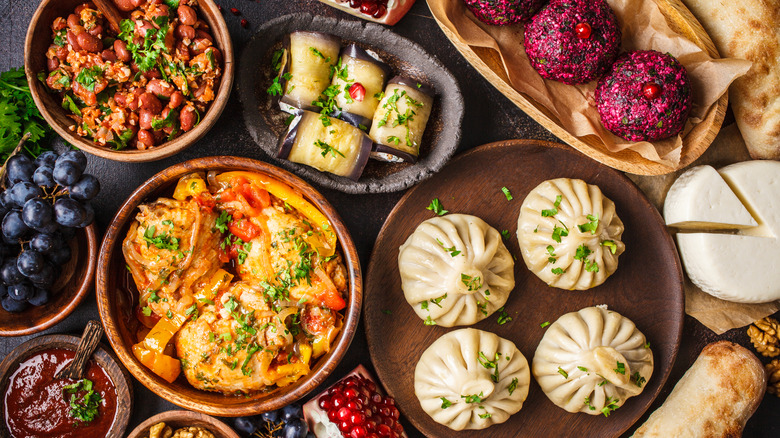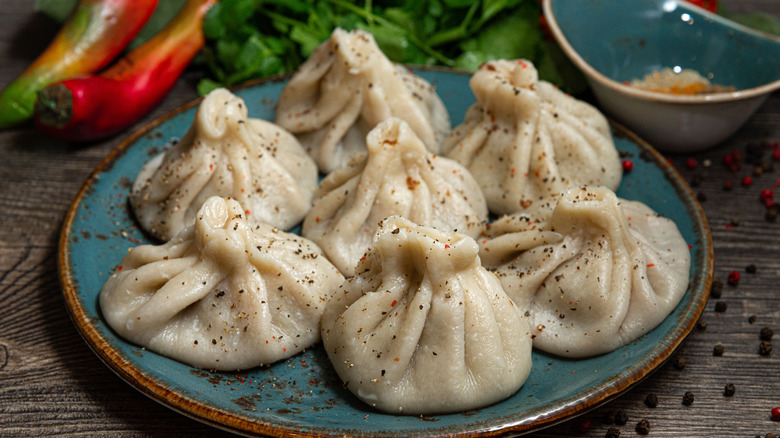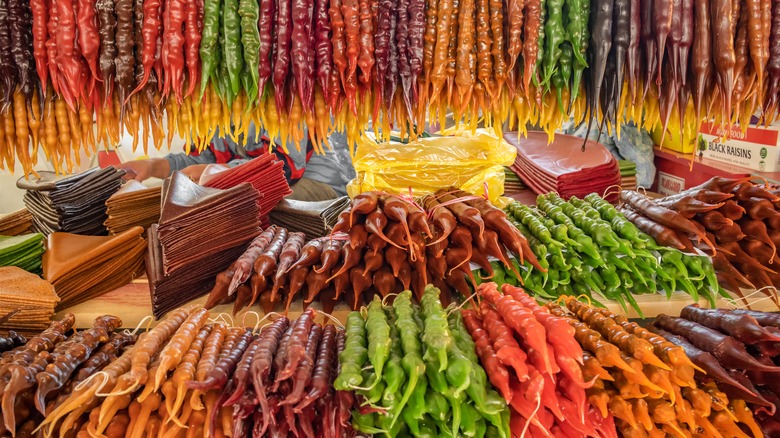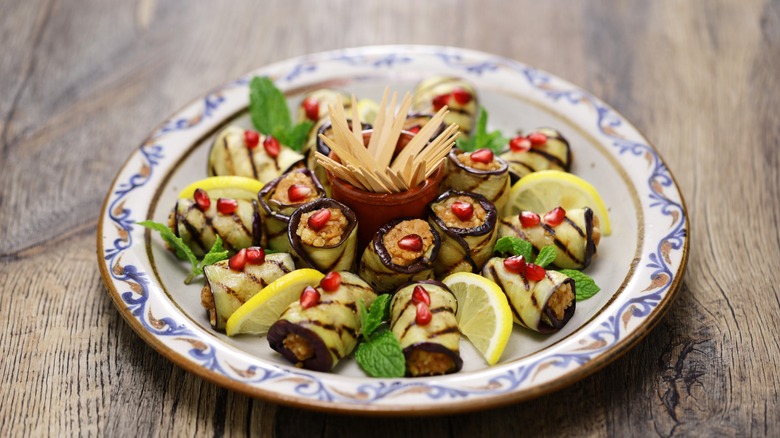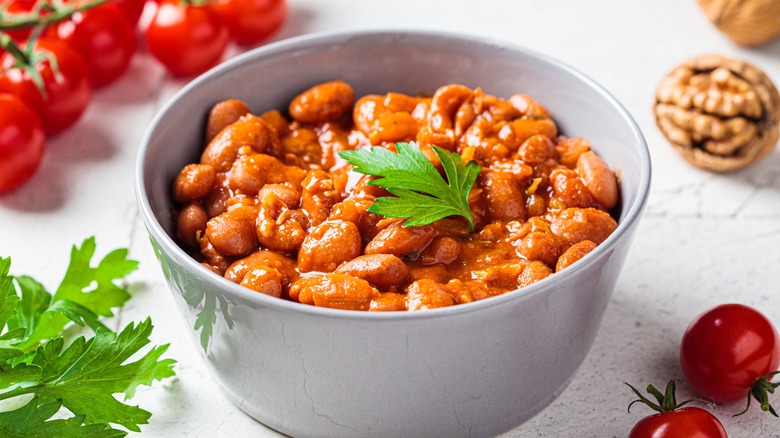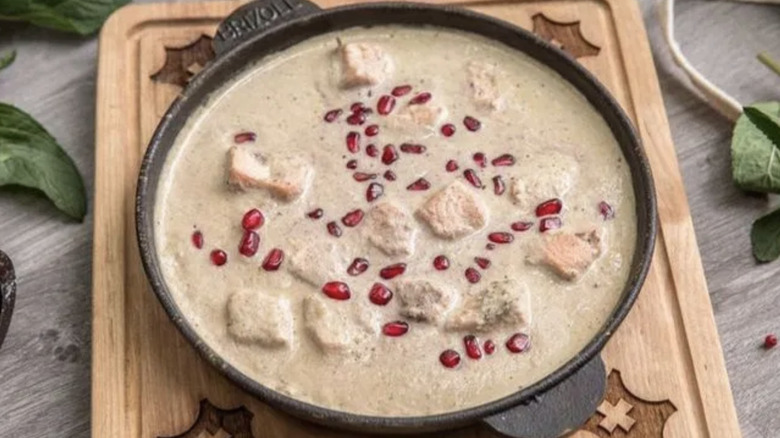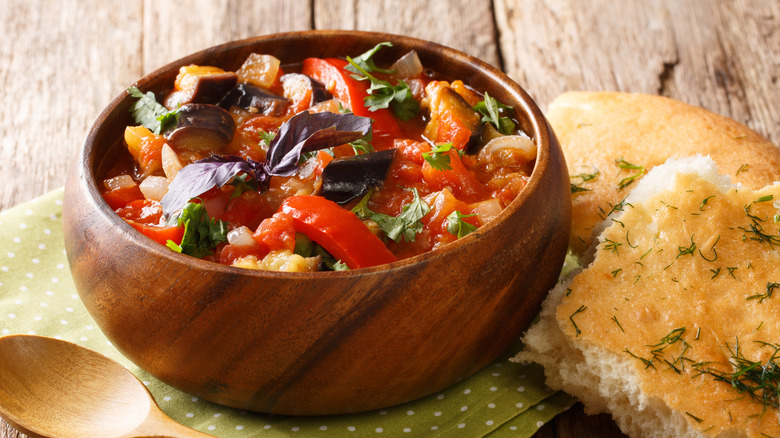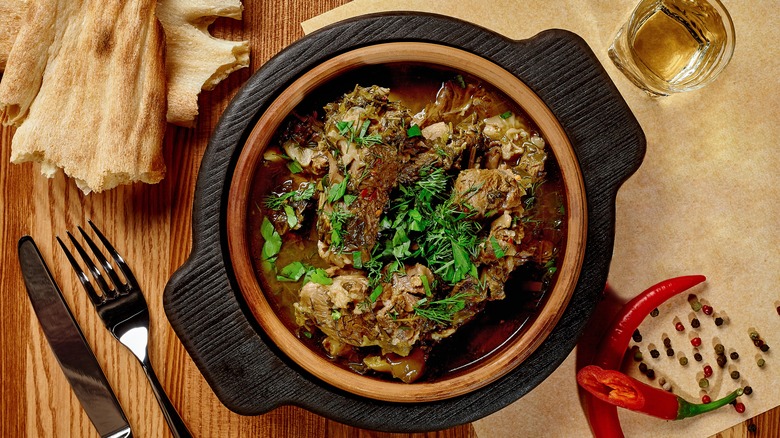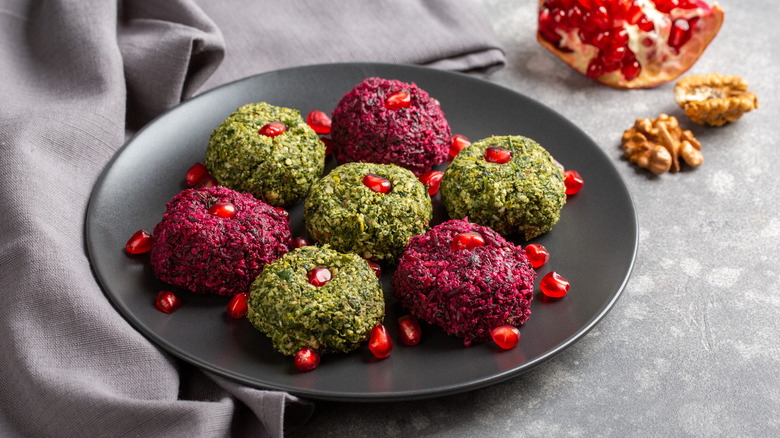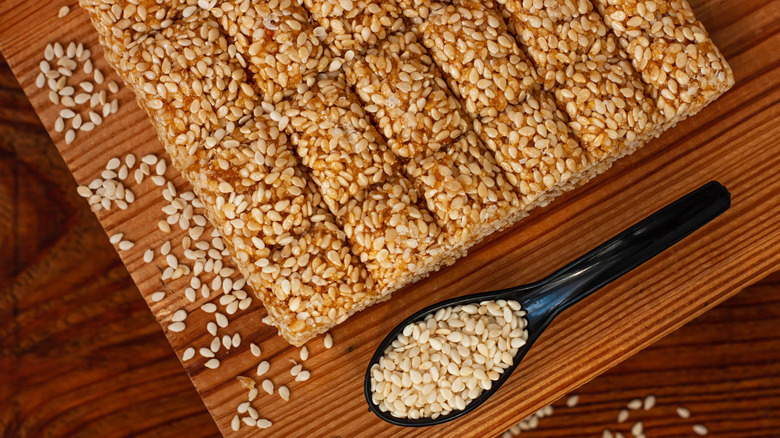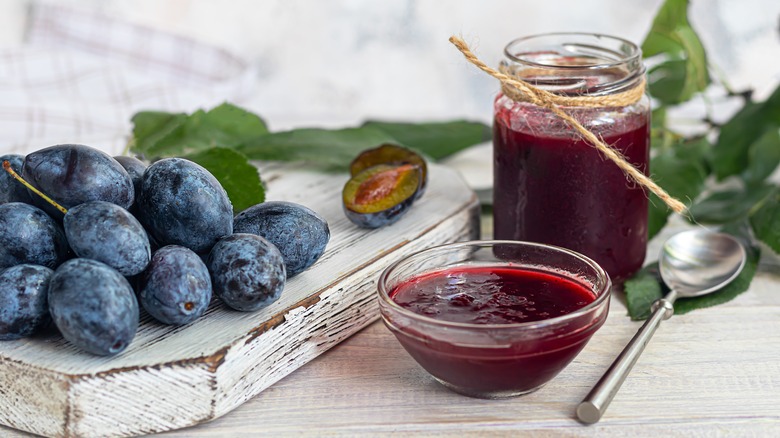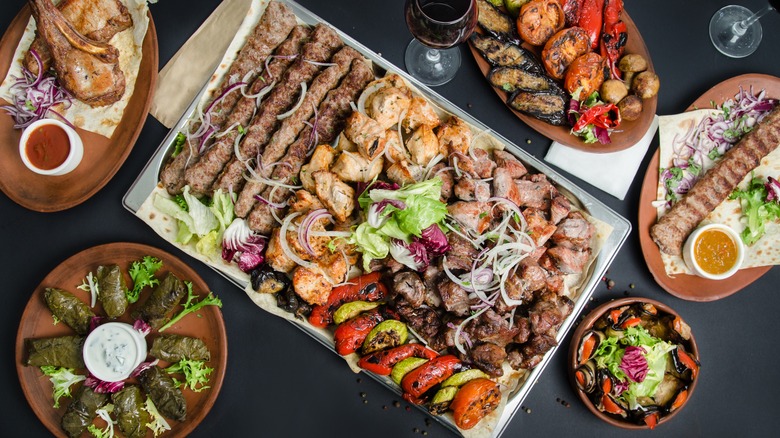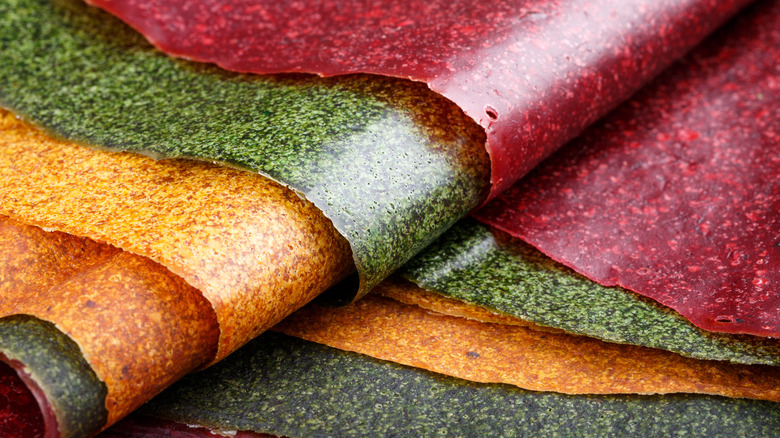13 Georgian Foods You Need To Try Before You Die
Nestled between Eastern Europe and West Asia, Georgia is flanked by the Black Sea to its west, Russia to its north, and Turkey, Armenia, and Azerbaijan to its south. Georgia's unique geographic position has made it a hub for the exchange of culinary ideas and techniques. As such, influences from Persian, Turkish, Iranian, and Russian cuisines have been woven into the fabric of Georgian gastronomy.
As diverse as its landscape, Georgia's cuisine is known for its bold flavors and textures. The country's culinary heritage stands out for its use of walnuts, pomegranates, garlic, and fresh herbs and spices like cilantro and fenugreek, which are key to creating distinctive flavors. These ingredients, combined with the country's penchant for hearty dishes, reflect a deep connection to its agricultural bounty.
Georgia's culinary scene is a delight for food enthusiasts, featuring must-try classics such as khinkali dumplings alongside a diverse selection of savory stews and delectable sweets. Ready to discover more about the cuisine of this vibrant country? Take a look at our list of Georgia's most popular dishes!
1. Khachapuri
This first dish is a celebration in simplicity. At its most basic khachapuri consists of just two ingredients: bread and cheese. Indeed, the name "khachapuri" itself is derived from two Georgian words meaning cheese curds and bread. While relatively uncomplicated, this beloved Georgian staple comes in various shapes and forms, depending on the region of the country where it originates.
One of the most popular types of khachapuri is called imeruli. Resembling a stuffed pizza, the circular dish features two layers of dough filled with cheese. Perhaps the most photogenic among the khachapuri is the adjarian, a boat-shaped dish with cheese, butter, and a cracked raw egg on top. While the dough of imeruli khachapuri is soft and fluffy, the adjarian version of the dish is more pizza-like in texture. Another firm favorite is megruli khachapuri, which is essentially a more decadent and gooey version of imeruli with an additional layer of cheese on top of the dough.
2. Khinkali
One of the highlights of a visit to a Georgian restaurant is khinkali, a striking dumpling dish characterized by its spiraling knobs of dough. These flavorful pouches are traditionally filled with a mixture of spiced meat, such as beef, pork, or lamb, herbs, and onions. Khinkali also usually contains a rich broth that fills the mouth with flavor upon the first bite. Just like with regular dumplings, there are vegetarian versions of the dish, which often come with mushrooms, mashed potatoes, or a mix of cheeses. While typically boiled, khinkali can also be deep-fried.
Eating khinkali is an art form — one that doesn't involve a knife and a fork. In fact, using utensils to enjoy these dumplings is considered a faux pas. To eat khinkali, hold each dumpling by its doughy knob — this is the only part of the dish that's not meant to be eaten. Next, bite into the dumpling, carefully sucking out the broth through the small opening before consuming the rest of the savory morsel.
3. Churchkhela
Colorful and eye-catching, churchkhela are a frequent sight at streetside stalls across Georgia. Candle-like in appearance, churchkhela are made by dipping strings of nuts into a concoction made from concentrated grape juice, sugar, and flour. This process is repeated several times before the candy is left out to dry for up to 17 days. Over this period, the grape mixture forms a distinct waxy and sweet coating around the nuts, making the outside of the treat leathery and chewy.
The flavors and colors of churchkhela vary. The snack usually contains walnuts, almonds, or hazelnuts, but can also occasionally be made with dried fruit such as apples, peaches, and plums. The hues of churchkhela also vary from light brown to deep burgundy, depending on the type of grapes used and their concentration.
Also sometimes called Georgian Snickers, churchkhela is a protein- and calorie-dense snack. It's very filling and can be stored for months without refrigeration. This makes churchkhela a perfect on-the-go option for travelers and anybody in need of a quick energy boost. Perhaps this is why, according to archaeological evidence, churchkhela was consumed by warriors who roamed the region in ancient times.
4. Badrijani nigvzit
Badrijani nigvzit translates to eggplant with walnuts, reflecting the dish's simplicity. Essentially, badrijani nigvzit is an appetizer made with fried eggplant slices rolled around a rich filling of walnut paste. The stuffing is combined with a variety of spices such as coriander seeds, cilantro, fenugreek, garlic, and sometimes cayenne or red pepper flakes, giving the dish a distinctive and robust flavor profile. Sometimes a touch of apple cider vinegar is also added to the mix. Badrijani nigvzit is normally garnished with bright red pomegranate seeds, adding both visual appeal and a burst of sweetness.
To make badrijani nigvzit, cut the eggplant lengthwise into quarter-inch-thick slices. Salt the slices and leave them to rest for about 30 minutes to draw out moisture and any bitterness. Pat the slices dry with paper towels. Next, heat a pan with oil and fry the eggplant slices until golden brown on both sides. Once fried, place them on paper towels to cool and remove any excess oil. For the walnut filling, blend ground walnuts with your range of chosen spices in a food processor, adding a little water to create a paste that's similar to hummus. Finally, spread this paste over each eggplant slice, before rolling it up into a tube.
5. Lobio
While lobio may not be as flashy as some other Georgian specialties, the dish is a beloved staple that can serve both as a main course and as a side dish. Especially popular during the winter months due to its warming properties, lobio is a hearty stew made with beans and walnuts. Moreover, since beans are a rich source of protein, fiber, and essential nutrients, lobio is a great choice for the health-conscious.
While making lobio traditionally involved soaking dry beans in water, this process has been simplified. Today, canned red kidney beans are frequently used to make the dish, offering a more convenient and time-efficient alternative. To make lobio, the beans are typically combined with garlic, onion, tomato paste, walnuts, and spices. Some recipe variations also call for meat and a sour ingredient such as cherry juice, pomegranate juice, or tkemali, which is a Georgian sour plum sauce. Depending on the desired end result, you can keep the beans intact or mash them. Traditionally served in a clay pot, lobio is frequently accompanied with pickled veggies and Georgian cornbread.
6. Satsivi
A celebration of both flavors and textures, satsivi is a perfect example of Georgia's obsession with walnuts. While this dish is typically made with some sort of protein, satsivi actually refers to a type of sauce. Thick and creamy, the sauce is made with ground walnuts and flavorful ingredients such as coriander, garlic, cumin, cinnamon, and other spices. While traditionally offered chilled — the word "tsivi" translates to cold in Georgian — satsivi can also be served hot or at room temperature.
While satsivi is typically made with chicken, and occasionally with seafood and vegetables, the traditional version of the dish incorporates turkey. Beyond its roots, the adaptability of satsivi sauce means that it can be a creative component in vegetarian and pescatarian dishes. For instance, the spongy texture of eggplant makes it an excellent vegetarian substitute for meat in satsivi. Fish also pairs well with the rich, nutty flavors of the sauce, offering a lighter but equally satisfying alternative to poultry.
7. Ajapsandali
Ideal for vegetarians and vegans alike, ajapsandali is a ratatouille-type stew that's both nourishing and tasty. A vibrant tapestry of flavors and colors, ajapsandali is a spicy concoction made with veggies that include tomatoes, eggplants, and peppers. Its uniqueness also lies in the addition of aromatic herbs like cilantro and parsley as well as spices such as blue fenugreek or chilies. The dish is usually served cold — though not always — around 24 hours after it's cooked, once the flavors have all melded together and the concoction has reached its optimal flavor. Ajapsandali is served with tonispuri, a chewy Georgian bread made in a tone, a tandoor-like oven.
While the recipe for ajapsandali isn't set in stone — in fact, far from it — there are certain regional takes on the dish that can be found across Georgia. In the central Georgian area of Imereti, ajapsandali tends to be on the thicker side and served with grilled meats. Venturing west to Samegrelo, the ajapsandali takes on an extra fiery character. Meanwhile, in the wine region of Kakheti, locals drizzle hot ajapsandali with unrefined sunflower oil right before serving.
8. Chakapuli
Chakapuli is a stew that stands out due to its ingredients. Invigorating and aromatic, the dish is made with lamb or veal as well as white wine, unripe cherry plums, and tarragon. Some of the ingredients are available only seasonally, hence the dish's association with spring. Chakapuli is particularly popular during Easter when it's often served as a part of the festive meals prepared to celebrate the occasion.
As uncomplicated to make as it is satisfying to savor, chakapuli involves cutting the meat into chunks and chopping up the other ingredients such as unripe cherry plums, garlic, tarragon, and onions. Next, these ingredients should be placed in a pot with a little water and white wine and stewed for an hour or two. A little butter can also be added to the mix. To imbue the dish with extra flavor, fry the onion and garlic and brown the lamb or veal before adding them to the pot with the rest of the ingredients.
9. Pkhali
A Georgian version of dips, pkhali is a colorful and versatile dish made from chopped or blended vegetables such as beet, cabbage, eggplant, and spinach. The spread is also often mixed with ground walnuts, herbs, garlic, and spices. It can be served alone or on top of bread, crackers, or vegetables. However, unlike regular dips, pkhali tend to have a rather thick consistency, enabling the spread to be rolled into balls or shaped into patties prior to serving. The dish is usually sprinkled with pomegranate seeds.
While pkhali can be prepared with a variety of vegetables, the most popular versions of the dish are made with either spinach or beetroot. To make pkhali, begin by cooking your selected vegetables until soft. Afterward, turn them into a paste by chopping them finely with a knife, crushing them in a mortar and pestle, or popping them into a food processor. Add ground walnuts, cilantro, and garlic, mixing them until the spread reaches the consistency of a paste. Next, add other ingredients such as white wine vinegar, blue fenugreek, coriander, cayenne pepper, and a little sunflower oil. Pkhali should be refrigerated for at least an hour before serving.
10. Gozinaki
Sweet and crunchy, Georgian gozinaki is made from a combination of toasted nuts and honey. While the brittle-style treat can be prepared with pretty much any nuts, its most common version contains walnuts and comes in diamond-shaped segments. While gozinaki can be enjoyed all year round, the sweet is usually served during festive occasions like New Year's Eve gatherings, weddings, and other celebrations.
The enduring popularity of gozinaki stems from its long shelf life, ease of preparation, and versatility, allowing for variations with different nuts and even sesame seeds and dried fruit. Some types of gozinaki are even dipped in chocolate for an added touch of indulgence.
The confection is believed to have originated in the 6th century with Georgian monks. It's also said that throughout history soldiers would often carry the highly portable snack with them as a quick source of energy and sustenance during long marches and battles.
11. Tkemali
A sauce rather than a dish, tkemali is a traditional Georgian sour plum condiment that's a favorite for its unique flavor and versatility in culinary applications. Traditionally made from unripe green plums, this tangy sauce is seasoned with a variety of spices, including cilantro, mint, garlic, and dill, all of which contribute to its distinctive taste. The condiment can also be made with red plums, provided they haven't become too ripe. While tkemali doesn't have a long shelf life, it can be frozen, making it accessible beyond the plum season.
What makes tkemali unique is not just its slightly tart flavor profile, but also its role in Georgian cuisine as a sauce that can accompany a wide range of dishes. In fact, some compare tkemali to chutney or tomato sauce. This versatility stems from the condiment's ability to enhance both meat and vegetarian dishes, adding a depth of flavor that is both unique and compelling. As such, the popular sauce is often used to add zest to grilled meats and seafood, stews, and potato dishes.
12. Mtsvadi
Mtsvadi is like a shish kebab and is characterized by its simplicity, its delicious flavors, and the communal preparation process. This dish, also known as shashlik in some regions, is traditionally made with marinated lamb, but these days pork and beef are also commonly used. In fact, some swear that pork neck is the best cut for achieving the perfect mtsvadi, thanks to its optimal balance of fat and meat. While the recipes for the marinade vary, many call for ingredients such as onion, white wine vinegar, and pomegranate juice, which tenderize the meat and imbue it with flavor.
Mtsvadi's preparation process involves skewering chunks of meat alongside vegetables such as zucchini and onion. Traditionally, the dish is prepared outdoors on an open fire, but these days barbecues are often used for both convenience and time-efficiency. Mtsvadi is often cooked using vine wood, which lends the meat a distinct smoky aroma that perfectly complements its natural flavors.
13. Tklapi
The Georgian answer to Fruit Roll-Ups, tklapi is a delicacy made from sun-dried pureed fruit. The confection is typically made from plum, but can also incorporate other fruit such as figs, pears, peaches, and apples. The chewy snack is made by spreading fruit puree over a surface and sun-drying it until it's firm but pliable — this usually takes between a few days to a week. Alternatively, a dehydrator can also be used to achieve a similar effect.
Beyond its delicious flavor, tklapi embodies Georgian traditions, reflecting the country's agricultural heritage and preservation methods. Tklapi is said to have emerged centuries ago in the mountains of Georgia where the climate presented significant obstacles to cultivating and storing fresh produce. Pureeing fruit and drying it let the locals enjoy the bounty of their labor all year around. Historically, the creation of tklapi involved a unique piece of equipment known as a tsitsila that was comprised of a stretched cloth and a wooden frame. Fruit puree was evenly spread across this cloth and then left in the sun until the concoction achieved the desired leathery texture.
